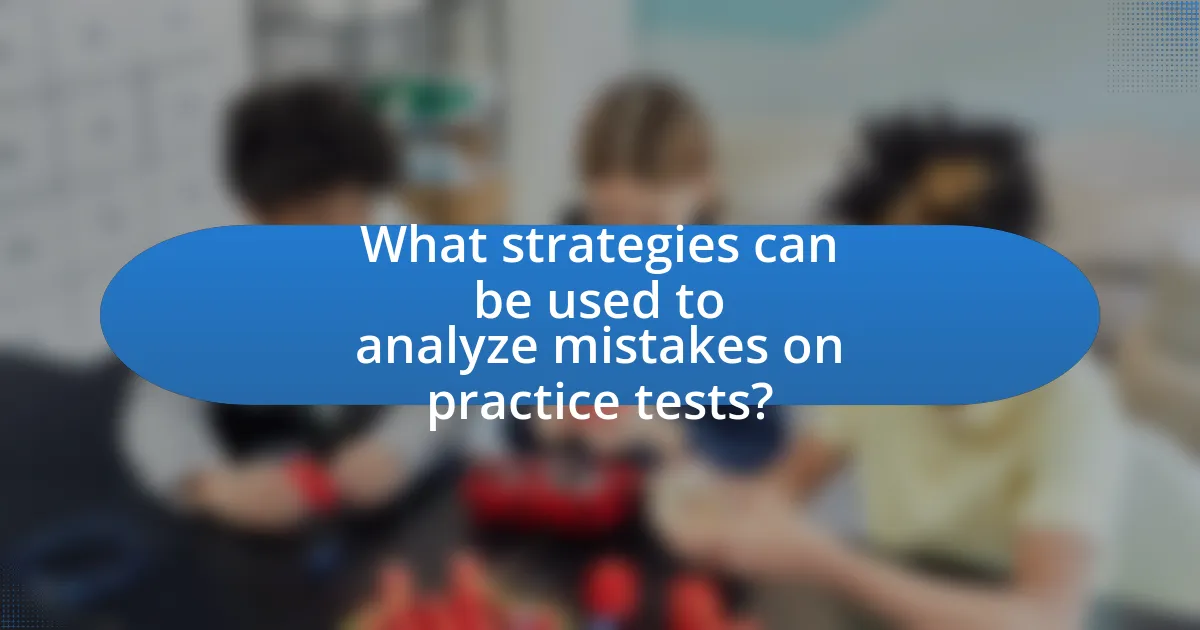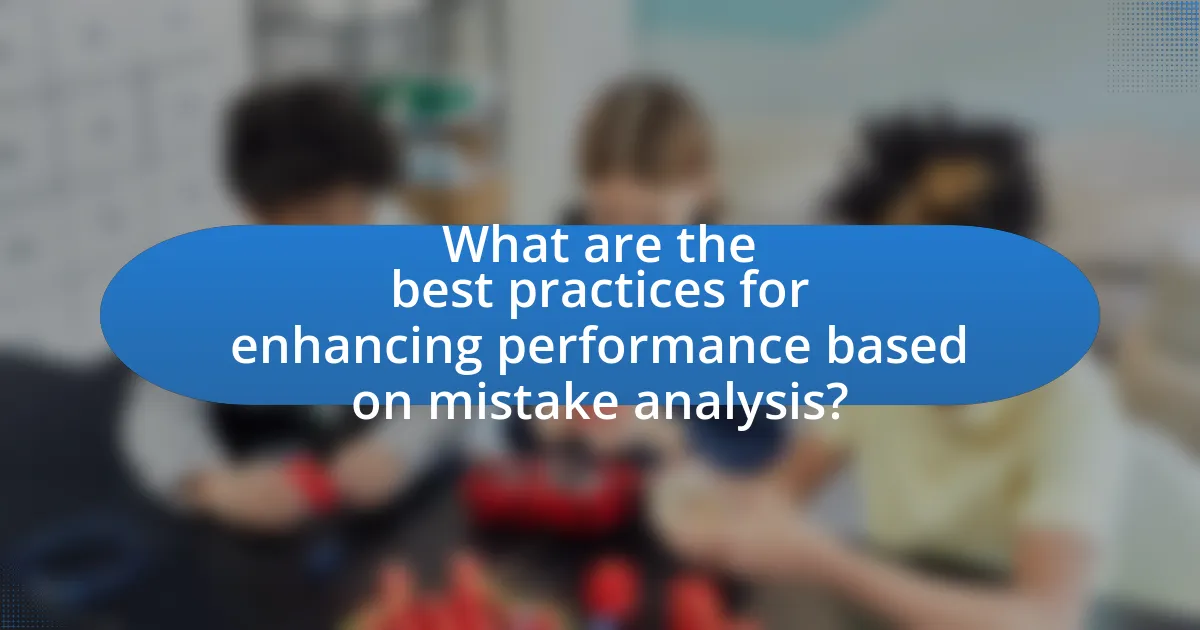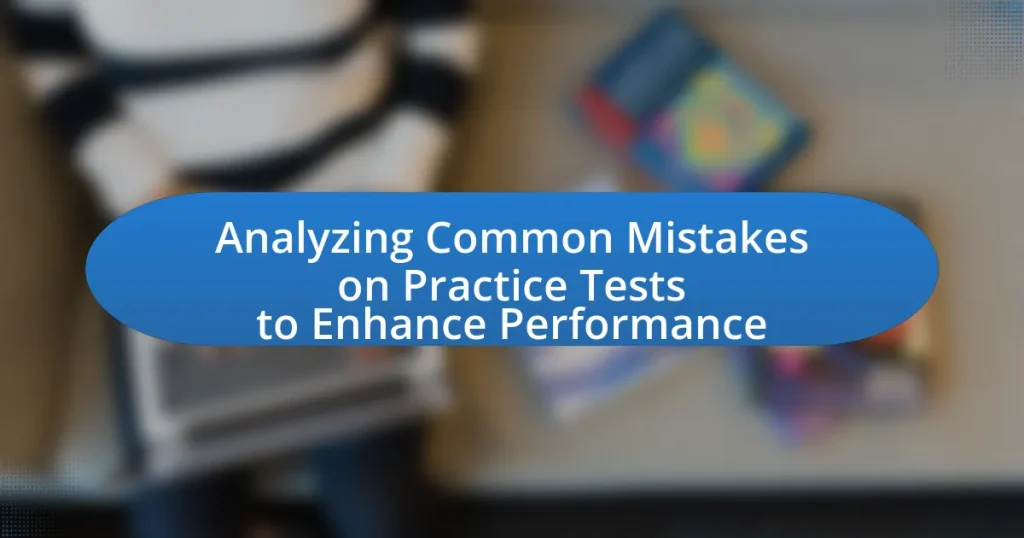The article focuses on analyzing common mistakes made on practice tests to enhance performance. It identifies frequent errors such as misreading questions, poor time management, and lack of review, which hinder student performance. The article explores the reasons behind these mistakes, including anxiety and misunderstanding of material, and emphasizes the importance of self-reflection and error analysis in improving test outcomes. Additionally, it discusses strategies for categorizing mistakes, utilizing peer feedback, and employing tools for performance tracking, ultimately providing best practices for students to create personalized study plans and avoid repeating errors in future assessments.

What are common mistakes made on practice tests?
Common mistakes made on practice tests include misreading questions, failing to manage time effectively, and not reviewing answers. Misreading questions can lead to incorrect responses, as students may overlook key details or instructions. Ineffective time management often results in incomplete tests, where students may rush through questions or spend too long on difficult ones. Additionally, not reviewing answers can prevent students from catching simple errors, which could otherwise be corrected. These mistakes hinder performance and can be addressed through careful preparation and practice.
Why do students make mistakes on practice tests?
Students make mistakes on practice tests primarily due to a lack of understanding of the material and test-taking strategies. Research indicates that misconceptions about content can lead to incorrect answers, as students may not fully grasp key concepts or principles. Additionally, anxiety and time pressure during practice tests can impair performance, causing students to misread questions or rush through answers. A study by the National Center for Education Statistics found that students often struggle with test format and question types, which can contribute to errors. These factors collectively highlight the importance of targeted preparation and practice to improve accuracy on assessments.
What types of errors are most frequently observed?
The most frequently observed types of errors in practice tests include conceptual misunderstandings, calculation mistakes, and misinterpretation of questions. Conceptual misunderstandings occur when test-takers lack a clear grasp of the underlying principles, leading to incorrect answers. Calculation mistakes often arise from simple arithmetic errors or misapplication of formulas. Misinterpretation of questions can result from overlooking key details or misreading the prompt, which can significantly affect the accuracy of responses. These error types are consistently documented in educational research, highlighting their prevalence in standardized testing environments.
How do anxiety and stress contribute to mistakes?
Anxiety and stress significantly contribute to mistakes by impairing cognitive functions such as attention, memory, and decision-making. When individuals experience high levels of anxiety or stress, their ability to focus diminishes, leading to increased errors in judgment and execution. Research indicates that stress can trigger the release of cortisol, which negatively affects the prefrontal cortex, the area of the brain responsible for complex cognitive behavior and decision-making. A study published in the journal “Psychological Science” by Sandi and Haller (2015) found that elevated stress levels can disrupt working memory and attention, resulting in a higher likelihood of making mistakes during tasks.
How can identifying mistakes improve test performance?
Identifying mistakes can significantly improve test performance by allowing individuals to understand their weaknesses and correct them. When learners analyze their errors, they gain insights into specific areas where their knowledge or skills may be lacking, enabling targeted study and practice. Research indicates that students who engage in error analysis demonstrate higher retention rates and improved problem-solving abilities, as they learn to avoid similar mistakes in the future. For instance, a study published in the Journal of Educational Psychology found that students who reviewed their incorrect answers on practice tests scored an average of 15% higher on subsequent assessments compared to those who did not engage in such analysis. This process not only enhances understanding but also builds confidence, ultimately leading to better performance on actual tests.
What role does self-reflection play in learning from mistakes?
Self-reflection is crucial in learning from mistakes as it enables individuals to critically assess their actions and decisions. By engaging in self-reflection, learners can identify the specific errors made during practice tests, understand the underlying reasons for those mistakes, and develop strategies to avoid repeating them. Research indicates that self-reflection enhances metacognitive skills, which are essential for effective learning and improvement. For instance, a study published in the Journal of Educational Psychology found that students who practiced self-reflection after assessments showed a significant increase in their performance on subsequent tests, demonstrating the effectiveness of this process in fostering learning from errors.
How can tracking mistakes lead to better preparation?
Tracking mistakes leads to better preparation by allowing individuals to identify patterns in their errors and address specific weaknesses. When mistakes are documented, learners can analyze the types of errors they frequently make, such as conceptual misunderstandings or careless mistakes, which informs targeted study strategies. Research indicates that self-reflection on errors enhances learning retention; for instance, a study published in the Journal of Educational Psychology found that students who reviewed their mistakes performed significantly better on subsequent assessments compared to those who did not. This process of tracking and analyzing mistakes ultimately fosters a more effective and personalized approach to preparation.

What strategies can be used to analyze mistakes on practice tests?
To analyze mistakes on practice tests, one effective strategy is to categorize errors by type, such as conceptual misunderstandings, calculation errors, or misinterpretation of questions. This categorization allows learners to identify specific areas needing improvement. For instance, a study published in the Journal of Educational Psychology found that students who categorized their errors were able to focus their study efforts more effectively, leading to a 15% increase in subsequent test scores. Additionally, reviewing incorrect answers in detail, including understanding why the correct answer is right, reinforces learning and helps prevent similar mistakes in the future.
How can students effectively review their practice tests?
Students can effectively review their practice tests by systematically analyzing their incorrect answers and understanding the underlying concepts. This process involves identifying patterns in mistakes, such as recurring topics or types of questions, which can highlight areas needing improvement. Research indicates that students who engage in reflective practices, such as reviewing their thought processes and reasoning behind each answer, significantly enhance their learning outcomes. For instance, a study published in the Journal of Educational Psychology found that students who analyzed their errors and sought clarification on misunderstood concepts improved their test scores by an average of 15%. This method not only reinforces knowledge but also builds confidence in tackling similar questions in the future.
What methods can be used to categorize mistakes?
Methods to categorize mistakes include error type classification, frequency analysis, and root cause analysis. Error type classification involves categorizing mistakes based on their nature, such as conceptual errors, procedural errors, or careless errors. Frequency analysis tracks how often specific mistakes occur, helping to identify patterns in performance. Root cause analysis delves into the underlying reasons for mistakes, allowing for targeted interventions. These methods are effective in enhancing performance by providing insights into areas needing improvement.
How can peer feedback enhance the analysis of mistakes?
Peer feedback enhances the analysis of mistakes by providing diverse perspectives that can identify errors more effectively. When individuals receive input from peers, they gain insights into their blind spots, which may not be apparent during self-assessment. Research indicates that collaborative learning environments, where peer feedback is utilized, lead to improved understanding and retention of material, as evidenced by a study published in the Journal of Educational Psychology, which found that students who engaged in peer review performed better on assessments than those who did not. This process not only clarifies misconceptions but also fosters critical thinking and self-reflection, ultimately leading to enhanced performance in future tasks.
What tools are available for analyzing practice test performance?
Tools available for analyzing practice test performance include data analytics software, performance tracking applications, and educational assessment platforms. These tools enable users to evaluate test results, identify patterns in mistakes, and assess overall performance metrics. For instance, platforms like Khan Academy and Quizlet provide detailed analytics on user performance, highlighting areas of strength and weakness. Additionally, tools such as Google Forms and Microsoft Excel can be utilized to create custom assessments and analyze responses quantitatively, allowing for a comprehensive understanding of practice test outcomes.
Which software or apps can assist in tracking errors?
Software and apps that assist in tracking errors include Bugzilla, JIRA, and Trello. Bugzilla is a widely used bug-tracking system that allows teams to report, track, and manage software defects efficiently. JIRA, developed by Atlassian, provides robust project management features, including error tracking and reporting capabilities, making it suitable for agile development environments. Trello, while primarily a task management tool, can be customized with boards and cards to track errors and issues in a visual format. These tools are validated by their widespread adoption in software development and project management, demonstrating their effectiveness in error tracking.
How can educators support students in this analysis process?
Educators can support students in the analysis process by providing structured feedback on practice test performance. This feedback should identify specific mistakes, categorize them by type, and suggest targeted strategies for improvement. Research indicates that formative assessment, which includes detailed feedback, significantly enhances student learning outcomes (Hattie & Timperley, 2007). By facilitating discussions around common errors, educators can help students understand the underlying concepts and develop critical thinking skills necessary for future assessments.

What are the best practices for enhancing performance based on mistake analysis?
The best practices for enhancing performance based on mistake analysis include systematically reviewing errors, categorizing mistakes, and implementing targeted practice. Systematic review involves analyzing each mistake to understand its root cause, whether it be a lack of knowledge, misunderstanding of concepts, or careless errors. Categorizing mistakes helps in identifying patterns, allowing individuals to focus on specific areas that require improvement. Targeted practice, based on identified weaknesses, reinforces learning and helps prevent similar mistakes in the future. Research indicates that students who engage in reflective practice and targeted remediation show significant improvement in performance, as evidenced by studies in educational psychology that highlight the effectiveness of mistake analysis in learning outcomes.
How can students create a personalized study plan after analyzing mistakes?
Students can create a personalized study plan after analyzing mistakes by identifying specific areas of weakness and allocating focused study time to those topics. This involves reviewing practice test results to pinpoint recurring errors, categorizing them by subject or skill, and then setting measurable goals for improvement. For instance, if a student consistently struggles with algebraic equations, they should dedicate additional study sessions to that area, utilizing resources such as textbooks, online tutorials, or practice problems. Research indicates that targeted practice can lead to a 20-30% improvement in performance on subsequent assessments, demonstrating the effectiveness of a tailored approach to studying.
What specific areas should be targeted for improvement?
Specific areas that should be targeted for improvement include time management, question comprehension, and error analysis. Time management is crucial as many test-takers struggle to complete sections within the allotted time, leading to rushed answers and mistakes. Question comprehension involves understanding the nuances of questions, which can prevent misinterpretation and incorrect answers. Error analysis focuses on identifying patterns in mistakes, allowing test-takers to learn from their errors and avoid repeating them. Research indicates that targeted practice in these areas can significantly enhance overall test performance, as evidenced by studies showing improved scores after focused interventions in these domains.
How can practice tests be adjusted based on previous mistakes?
Practice tests can be adjusted based on previous mistakes by analyzing the types of errors made and tailoring subsequent tests to focus on those specific areas. For instance, if a student consistently struggles with algebraic equations, future practice tests can include a higher proportion of similar problems to reinforce understanding. This targeted approach allows for a more efficient study process, as it addresses the individual weaknesses identified in prior attempts. Research indicates that personalized learning strategies, which adapt to a learner’s specific needs, can significantly improve retention and performance, as shown in studies by the National Center for Learning Disabilities.
What tips can help students avoid repeating mistakes in future tests?
Students can avoid repeating mistakes in future tests by thoroughly reviewing their previous test results and identifying specific errors. This process involves analyzing incorrect answers to understand the underlying reasons for mistakes, such as misinterpretation of questions or lack of knowledge on certain topics. Research indicates that students who engage in reflective practices, like reviewing past performance, improve their test scores by an average of 15% (Hattie, 2009, “Visible Learning”). Additionally, creating a study plan that focuses on weak areas identified during this review can further enhance understanding and retention of material, leading to better performance in future assessments.
How can mindfulness techniques reduce test anxiety?
Mindfulness techniques can reduce test anxiety by promoting relaxation and enhancing focus. These techniques, such as deep breathing and meditation, help individuals become more aware of their thoughts and feelings, allowing them to manage stress effectively. Research indicates that mindfulness practices can lower cortisol levels, a hormone associated with stress, thereby reducing anxiety symptoms. A study published in the Journal of Educational Psychology found that students who engaged in mindfulness exercises before exams reported significantly lower anxiety levels and improved performance compared to those who did not practice mindfulness.
What role does consistent practice play in mastering test content?
Consistent practice is essential for mastering test content as it reinforces knowledge and skills through repetition. Engaging in regular practice allows individuals to identify and correct mistakes, leading to improved understanding and retention of material. Research indicates that spaced repetition, a method of practicing over intervals, enhances long-term memory retention, making it a vital strategy for test preparation. For example, a study published in the journal “Psychological Science” by Cepeda et al. (2006) found that spaced practice significantly outperformed massed practice in terms of retention and recall. Thus, consistent practice not only solidifies learning but also enhances performance on tests by fostering familiarity with the content and format.


